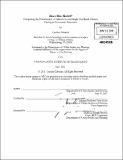| dc.contributor.advisor | Terry Szold. | en_US |
| dc.contributor.author | Edwards, Caroline (Caroline Todd) | en_US |
| dc.contributor.other | Massachusetts Institute of Technology. Dept. of Urban Studies and Planning. | en_US |
| dc.date.accessioned | 2011-11-01T19:47:06Z | |
| dc.date.available | 2011-11-01T19:47:06Z | |
| dc.date.copyright | 2011 | en_US |
| dc.date.issued | 2011 | en_US |
| dc.identifier.uri | http://hdl.handle.net/1721.1/66806 | |
| dc.description | Thesis (M.C.P.)--Massachusetts Institute of Technology, Dept. of Urban Studies and Planning, 2011. | en_US |
| dc.description | Cataloged from PDF version of thesis. | en_US |
| dc.description | Includes bibliographical references (p. 107-113). | en_US |
| dc.description.abstract | Retail development in suburban locations has long been dominated by retail "strips" along major roadways and large, enclosed shopping malls. More compact, planned alternatives to sprawl development have been gaining in popularity since the late 20' century, and many feature commercial centers that follow a different model. Drawing from "traditional" town centers, a key principle of sprawl alternatives such as smart growth and New Urbanism is to mix land uses, and retail often occurs within a vertical mixed-use form. The purpose of this research is to study one aspect of the economic viability of smart growth by comparing the retail resilience of mixed-use and single-use suburban developments during a difficult economic climate, the 2007-2009 recession. This study uses a case study-based methodology to compare the retail resilience, approximated by the change in number of retail and food service establishments, of mixed-use and single-use retail clusters before and during the 2007-2009 economic recession. Mixed-use clusters were expected to outperform single-use clusters during the economic downturn due to their built-in customer base and urban design that provides foot traffic for retailers without requiring a dedicated shopping trip. In a majority of case studies, however, the single-use cluster performed best during the economic recession. The results suggest that simply mixing land uses is not sufficient to create a strong, resilient retail environment. Planners and developers must rethink the design and programming of planned mixed-use communities to create better developments that are resilient in all economic climates. | en_US |
| dc.description.statementofresponsibility | by Caroline Edwards. | en_US |
| dc.format.extent | 113 p. | en_US |
| dc.language.iso | eng | en_US |
| dc.publisher | Massachusetts Institute of Technology | en_US |
| dc.rights | M.I.T. theses are protected by
copyright. They may be viewed from this source for any purpose, but
reproduction or distribution in any format is prohibited without written
permission. See provided URL for inquiries about permission. | en_US |
| dc.rights.uri | http://dspace.mit.edu/handle/1721.1/7582 | en_US |
| dc.subject | Urban Studies and Planning. | en_US |
| dc.title | Does mix matter? : comparing the performance of mixed-use and single-use retail clusters during an economic downturn | en_US |
| dc.title.alternative | Comparing the performance of mixed-use and single-use retail clusters during an economic downturn | en_US |
| dc.type | Thesis | en_US |
| dc.description.degree | M.C.P. | en_US |
| dc.contributor.department | Massachusetts Institute of Technology. Department of Urban Studies and Planning | |
| dc.identifier.oclc | 757150172 | en_US |
